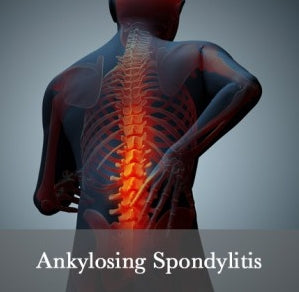
Ankylosing Spondylitis, Symptoms
Share

Ankylosing spondylitis (AS) is a type of chronic inflammatory arthritis that primarily affects the spine and sacroiliac joints, which connect the spine to the pelvis. Over time, inflammation in these areas can lead to pain, stiffness, and a gradual fusion of the vertebrae, which reduces flexibility and can result in a hunched posture. Studies show that Anklosing Spondylitis affects primarily the axial skeleton, causing pain, stiffness, and potential deformities due to progressive inflammation and new bone formation in the spine.So sometime it is also called as axial spondylarthritis.. Key mechanisms involve the overactivity of immune system components like TNF-α and the IL-23–IL-17 pathway, both of which are linked to Anklosing Spondlylitis onset and progression.

Common Symptoms of Ankylosing Spondylitis
-
Lower Back and Hip Pain: Pain often begins in the lower back and hips, especially around the sacroiliac joints (where the spine meets the pelvis). This pain is typically worse in the morning or after periods of inactivity, improving with movement.
-
Morning Stiffness: Prolonged stiffness, particularly after waking up or sitting for long periods, is common in AS. Movement and stretching usually help alleviate this stiffness.
-
Pain and Stiffness in Other Joints: Although AS primarily affects the spine, it can also impact other joints, such as the shoulders, hips, and ribs, leading to limited motion and discomfort in these areas.
-
Reduced Flexibility: As the condition progresses, it can cause sections of the spine to fuse, limiting spinal flexibility and causing a characteristic stooped posture.
-
Fatigue: Chronic inflammation from AS often leads to general fatigue, leaving individuals feeling tired and drained.
-
Enthesitis: AS can cause inflammation at the sites where tendons and ligaments attach to bones, especially around the heels, hips, and ribs, causing pain in these areas
-
Eye Inflammation (Uveitis): Uveitis, or inflammation of the eye, occurs in some individuals with AS, causing eye pain, redness, and sensitivity to light.
-
Loss of Appetite and Weight Loss: In severe or advanced cases, some people may experience decreased appetite and unintentional weight loss.
Treatment available for Ankylosing Spondylitis
Ankylosing Spondylitis (AS) is primarily managed through treatments that focus on reducing pain, maintaining spinal flexibility, and slowing disease progression. While there is currently no cure, various treatment options can improve quality of life for those with AS.
1. Medications
Consulting a healthcare provider is crucial when experiencing these symptoms.
2. Physical Therapy and Exercise
- Stretching and Flexibility Exercises: Regular stretching can help maintain spinal flexibility and reduce stiffness.
- Strengthening and Core Exercises: Strengthening the back and core muscles provides support for the spine and can help reduce pain.
- Posture Training: Physical therapists can assist with posture correction, helping to prevent the characteristic forward-bending posture often seen in AS patients.
3. Lifestyle Adjustments
- Anti-Inflammatory Diets: Foods rich in omega-3s, fruits, vegetables, and whole grains may help reduce inflammation.
- Regular Low-Impact Exercise: Activities like swimming, walking, and yoga can help maintain mobility without stressing the joints.
- Avoiding Smoking: Smoking can worsen AS symptoms and increase the risk of cardiovascular complications, which are more common in AS patients.
4. Assistive Devices and Surgery (for Severe Cases)
- Assistive Devices: Braces, shoe inserts, or other supportive devices can help with mobility and pain management in cases where AS severely impacts the joints.
- Surgical Interventions: In rare cases, joint replacement (e.g., hip replacement) or corrective spinal surgery may be necessary if spinal fusion severely limits movement or causes nerve compression.
5. Alternative and Complementary Therapies
- Acupuncture and Massage: These may provide temporary pain relief and improve relaxation, though they don’t address the underlying inflammation.
- Heat and Cold Therapy: Alternating heat and cold can help manage stiffness and pain, especially during flare-ups.
- Supplement : Supplements may help manage symptoms of Ankylosing Spondylitis (AS) by targeting inflammation, supporting joint health, and potentially reducing pain.

6. Regular Monitoring and Lifestyle Counseling
- Managing AS requires regular check-ups to monitor for complications, including cardiovascular health and eye inflammation. Counseling on lifestyle modifications like weight management, stress reduction, and adherence to exercise can further support long-term health.
Conclusion
Ankylosing Spondylitis (AS) is a chronic inflammatory condition that predominantly affects the spine, leading to pain, stiffness, and potential complications, such as spinal fusion and decreased flexibility. Early symptoms like lower back pain, morning stiffness, and joint discomfort often serve as initial warning signs and highlight the importance of early detection and intervention. Though AS currently has no cure, treatment strategies—including medication or supplements, physical therapy, lifestyle changes, and alternative therapies—can help alleviate symptoms, preserve mobility, and improve overall quality of life.
Targeted interventions like anti-inflammatory diets, regular exercise, and supplement support may also enhance symptom management, while regular monitoring ensures timely adjustments to treatment. Collaborating with healthcare providers and making necessary lifestyle adjustments are key to managing AS effectively and maintaining independence and comfort in daily life.
